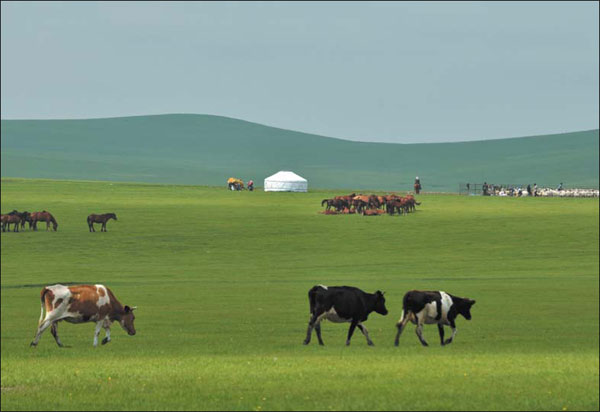Official: Modern tourism to transform economy
Senior officials in Inner Mongolia vow to accelerate the development of the local tourismindustry to not only boost economic growth, but also respond to State Council guidelines issuedin 2011, according to Bater, chairman of the autonomous region.
Known for its vast grasslands accounting for 27 percent of the nation's total, Inner Mongoliahas the six pasturelands in Hulunbuir, Horqin, Xilin Gol, Ulanqab, Ordos and Alxa areas.
The region also has many renowned historical relics such as the Tomb of Genghis Khan andthe Tomb of Wang Zhaojun, a large earthen pyramid made for the remains of one of the fourgreat beauties of ancient times.
Deserts, lakes and forests also attract visitors who want to embrace nature.
"With more high-quality modern services provided, our goal is to turn the autonomous regioninto an appealing destination for grassland tourism in China as well as a sign of ecologicaltourism and cultural experience," said Bater, who like all Mongolians has a single name.
And the region's tourism industry has undergone a clear change in recent years, he added.
It has become a major new engine driving the economic growth and social transformation in Inner Mongolia.
Statistics from the region's tourism bureau show that during the11th Five-Year Plan period (2006-10), tourist numbers grew 16.8 percent each year and revenues increased 28.6 percent, both higher than the national average.
Tourism can also promote the growth of more than 100 relatedindustries such as restaurants, transportation and entertainment,Bater said.
He noted that every 1 yuan in tourism income brings 4.3 yuan innew income along the industry chain.
And as a "green" industry, tourism will gradually help improve theoverall industrial structure and transform the economic system, hesaid.
It is also a labor-intensive industry, which is an effective way toease unemployment and improve people's quality of life , headded.
The region now has 180,000 residents in tourism-relatedindustries and services.
"A series of actions will be taken to support the industrydevelopment," said the chairman.
The government will create a better environment for tourism investment, adopt preferentialpolicies for tourism projects and help lower operating costs of travel agencies and companies.
By 2015, major indexes that measure the tourism industry are expected to double over 2010.Total income is projected to reach 150 billion yuan, about 8 percent of the region's GDP, Bateradded.
haonan@chinadaily.com.cn
(China Daily 05/27/2013 page 15)
Known for its vast grasslands accounting for 27 percent of the nation's total, Inner Mongoliahas the six pasturelands in Hulunbuir, Horqin, Xilin Gol, Ulanqab, Ordos and Alxa areas.
The region also has many renowned historical relics such as the Tomb of Genghis Khan andthe Tomb of Wang Zhaojun, a large earthen pyramid made for the remains of one of the fourgreat beauties of ancient times.
Deserts, lakes and forests also attract visitors who want to embrace nature.
"With more high-quality modern services provided, our goal is to turn the autonomous regioninto an appealing destination for grassland tourism in China as well as a sign of ecologicaltourism and cultural experience," said Bater, who like all Mongolians has a single name.
And the region's tourism industry has undergone a clear change in recent years, he added.
It has become a major new engine driving the economic growth and social transformation in Inner Mongolia.
Statistics from the region's tourism bureau show that during the11th Five-Year Plan period (2006-10), tourist numbers grew 16.8 percent each year and revenues increased 28.6 percent, both higher than the national average.
Tourism can also promote the growth of more than 100 relatedindustries such as restaurants, transportation and entertainment,Bater said.
He noted that every 1 yuan in tourism income brings 4.3 yuan innew income along the industry chain.
And as a "green" industry, tourism will gradually help improve theoverall industrial structure and transform the economic system, hesaid.
It is also a labor-intensive industry, which is an effective way toease unemployment and improve people's quality of life , headded.
The region now has 180,000 residents in tourism-relatedindustries and services.
"A series of actions will be taken to support the industrydevelopment," said the chairman.
The government will create a better environment for tourism investment, adopt preferentialpolicies for tourism projects and help lower operating costs of travel agencies and companies.
By 2015, major indexes that measure the tourism industry are expected to double over 2010.Total income is projected to reach 150 billion yuan, about 8 percent of the region's GDP, Bateradded.
haonan@chinadaily.com.cn
(China Daily 05/27/2013 page 15)

Comments
Post a Comment